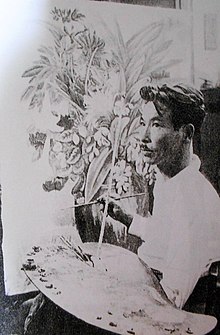Kitagawa Tamiji
Kitagawa Tamiji ( Japanese 北 川 民 次 ; born August 19, 1894 in Kanaya ( Shizuoka Prefecture ); died June 6, 1989 in Seto ) was a Japanese painter of the Yōga style in the Taishō and Shōwa periods . He spent an important part of his life in Mexico .
life and work
Kitagawa graduated from Shizuoka Commercial School and enrolled in Waseda University . He did not finish his studies there, but went to New York with the help of an uncle who lived in California. From 1917 he studied at the evening school of the Art Students League of New York under John Sloan , where he graduated in 1921. During that time, he became friends with Kuniyoshi Yasuo . Kitagawa left New York in 1923 and roamed various countries in Central and South America before settling in Orizaba, Mexico. There he became a santero , a street vendor of religious images.
From 1924, Kitagawa attended the Escuela Nacional de Bellas Artes in Mexico City, which made him a scholarship available and from which he graduated after three months. In 1925 he attended the art school of Churubusco , where he exchanged ideas with Orozco , Rivera and Siqueiros - the "Los Tres Grandes". From 1925 he worked in one of the open-air schools ("Escuelas de Pintura al Aire Libre") and joined the post-revolutionary art movement in Mexico. Kitagawa moved to Tasco in 1931 and became the director of the local open-air school.
In 1936 he returned to Japan and showed in the following year in the 24th annual exhibition of the Nika-kai ( 二 科 会 ) pictures, including "Holidays in Tasco (Mexico)" ( メ キ シ コ 、 タ ス コ の 祭日 , Mekishiko, Tasuko no saijitsu ) and " three girls in Mexico ”( メ キ シ コ の 三人 娘 , Mekishiko no sannin musume ). He was accepted as a member of the Nikakai ( 二 科 会 ) art association.
In 1943 he moved to Seto in Aichi Prefecture and in 1949 he opened in Nagoya , the "Nagoya-art school at the Zoo" ( 名古屋動物園美術学校 , Nagoya Dobutsuen bijutsu Gakko ), and in 1951, also in Nagoya, he founded the "Kitagawa Institute for Children's Art ”( 北 川 児 童 美術 研究所 , Kitawawa jidō bijutsu kenkyūjo ). - In 1952 he won the Chūnichi Culture Prize ( 中 日 文化 賞 , Chūnichi bunka-shō ).
Kitagawa visited Mexico a second time in 1955, seeing Siqueiros and Tamayo again. The following year he traveled through France, Spain and Italy. In 1959 he finished a marble mosaic for the CBC building in Nagoya with the title “Peace and Art” ( 平和 と 美術 , Heiwa to bijutsu ) and a brick mosaic for the community hall in Seto with the title “Clay Mounds and Clay Tombs” ( 凍土 の山 と 採掘 夫 ). In 1964 he submitted his picture “ Raising a Child” ( 保育 , Hoiku ) to the 6th annual Japanese Contemporary Art Exhibition ( 現代 日本 美術展 , Gendai Nihon bijutsu-ten ) and won the “Award for an Extraordinary Work” ( 優秀 賞 , Yushu-sho ). Kitagawa continued to submit pictures to Nika-kai exhibitions. But when he was asked in 1978 after Tōgō Seiji's death to succeed him, he withdrew from the club.
Kitagawa dealt with social issues from the start, creating a style that can be described as "social expressionism". He also wrote such writings as "Children who Draw Pictures" ( 絵 を 描 く 子 供 た ち ), "Temptation of Mexico" ( メ キ シ コ の 誘惑 ), and the "Philosophy and Aphorisms of the Locust: A Collection of Prints by Kitagawa Tamiji". ( 飛蝗 の 哲学 - ア フ ォ リ ズ ム: 北 川 民 次 版 画集 , Batta no tetsugaku - aphorisms: Kitagawa Tamiji hanga-shū ).
literature
- Suzuki, Toshihiko (Ed.): Kitagawa Tamiji . In: Nihon daihyakka zensho (Denshibukku-han), Shogakukan, 1996.
- Tazawa, Yutaka: Kitagawa Tamiji . In :: Biographical Dictionary of Japanese Art. Kodansha International, 1981. ISBN 0-87011-488-3 .
- Laurence P. Roberts: Kitagawa Tamiji . In: A Dictionary of Japanese Artists. Weatherhill, 1976. ISBN 0-8348-0113-2 .
Web links
Remarks
| personal data | |
|---|---|
| SURNAME | Kitagawa, Tamiji |
| ALTERNATIVE NAMES | 北 川 民 次 (Japanese) |
| BRIEF DESCRIPTION | Japanese artist |
| DATE OF BIRTH | August 19, 1894 |
| PLACE OF BIRTH | Kanaya ( Shizuoka Prefecture ) |
| DATE OF DEATH | June 6, 1989 |
| Place of death | Seto , Aichi Prefecture |
